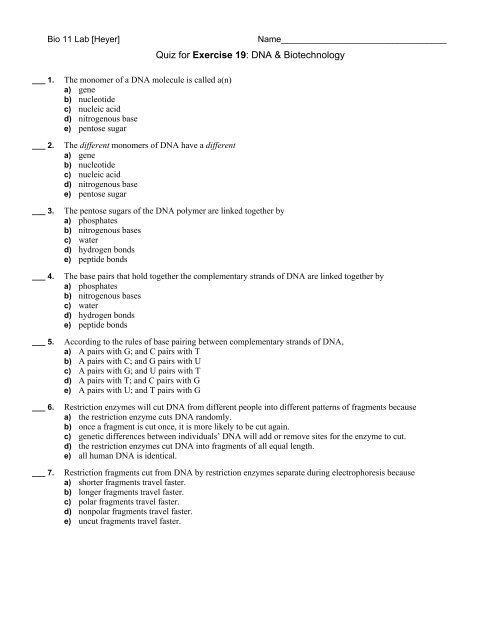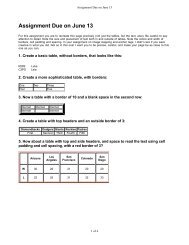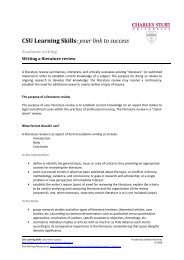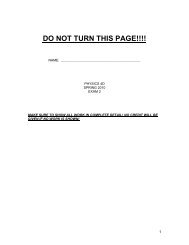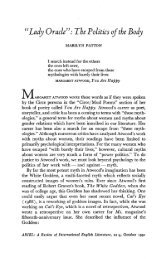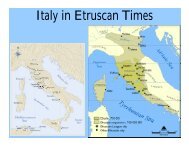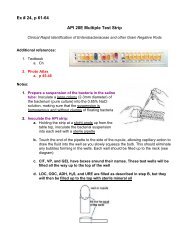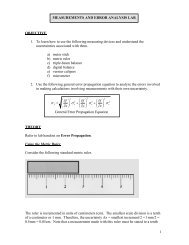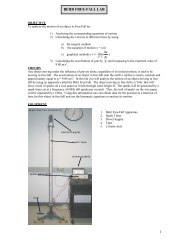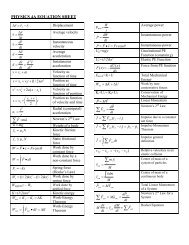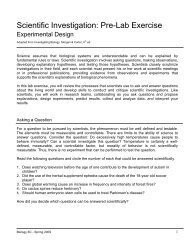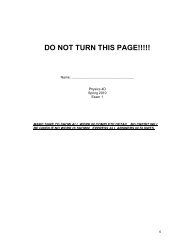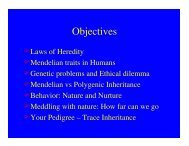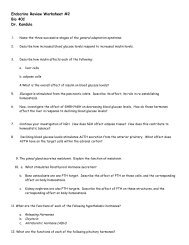Quiz for Exercise 19: DNA & Biotechnology - De Anza College
Quiz for Exercise 19: DNA & Biotechnology - De Anza College
Quiz for Exercise 19: DNA & Biotechnology - De Anza College
You also want an ePaper? Increase the reach of your titles
YUMPU automatically turns print PDFs into web optimized ePapers that Google loves.
Bio 11 Lab [Heyer]<br />
<strong>Quiz</strong> <strong>for</strong> <strong>Exercise</strong> <strong>19</strong>: <strong>DNA</strong> & <strong>Biotechnology</strong><br />
Name__________________________________<br />
___ 1.<br />
___ 2.<br />
___ 3.<br />
___ 4.<br />
___ 5.<br />
___ 6.<br />
___ 7.<br />
The monomer of a <strong>DNA</strong> molecule is called a(n)<br />
a) gene<br />
b) nucleotide<br />
c) nucleic acid<br />
d) nitrogenous base<br />
e) pentose sugar<br />
The different monomers of <strong>DNA</strong> have a different<br />
a) gene<br />
b) nucleotide<br />
c) nucleic acid<br />
d) nitrogenous base<br />
e) pentose sugar<br />
The pentose sugars of the <strong>DNA</strong> polymer are linked together by<br />
a) phosphates<br />
b) nitrogenous bases<br />
c) water<br />
d) hydrogen bonds<br />
e) peptide bonds<br />
The base pairs that hold together the complementary strands of <strong>DNA</strong> are linked together by<br />
a) phosphates<br />
b) nitrogenous bases<br />
c) water<br />
d) hydrogen bonds<br />
e) peptide bonds<br />
According to the rules of base pairing between complementary strands of <strong>DNA</strong>,<br />
a) A pairs with G; and C pairs with T<br />
b) A pairs with C; and G pairs with U<br />
c) A pairs with G; and U pairs with T<br />
d) A pairs with T; and C pairs with G<br />
e) A pairs with U; and T pairs with G<br />
Restriction enzymes will cut <strong>DNA</strong> from different people into different patterns of fragments because<br />
a) the restriction enzyme cuts <strong>DNA</strong> randomly.<br />
b) once a fragment is cut once, it is more likely to be cut again.<br />
c) genetic differences between individuals’ <strong>DNA</strong> will add or remove sites <strong>for</strong> the enzyme to cut.<br />
d) the restriction enzymes cut <strong>DNA</strong> into fragments of all equal length.<br />
e) all human <strong>DNA</strong> is identical.<br />
Restriction fragments cut from <strong>DNA</strong> by restriction enzymes separate during electrophoresis because<br />
a) shorter fragments travel faster.<br />
b) longer fragments travel faster.<br />
c) polar fragments travel faster.<br />
d) nonpolar fragments travel faster.<br />
e) uncut fragments travel faster.
For Questions 8–11, consider the following scenario:<br />
A 23 year old male was found murdered in the hallway of his apartment building. Investigators collected many<br />
samples of evidence including blood found on a knife near the body and hair from the victim's shirt. Police had<br />
two suspects due to eye-witness accounts. Both suspects, the victim and the evidence were analyzed using <strong>DNA</strong><br />
fingerprinting.<br />
<strong>DNA</strong> fingerprint: electrophoresis of restriction fragments<br />
___ 8.<br />
___ 9.<br />
Who does the blood evidence found at the crime scene most likely belong to?<br />
a) the victim<br />
b) suspect #1<br />
c) suspect #2<br />
d) both the victim and suspect #1<br />
e) both the victim and suspect #2<br />
Who does the hair evidence found at the crime scene most likely belong to?<br />
a) the victim<br />
b) suspect #1<br />
c) suspect #2<br />
d) both the victim and suspect #1<br />
e) both the victim and suspect #2<br />
___ 10. What does the <strong>for</strong>ensic <strong>DNA</strong> analysis say most clearly about Suspect #1?<br />
a) She’s innocent.<br />
b) She’s guilty.<br />
c) She was at the scene at the time of the crime.<br />
d) Someone matching her genetic fingerprint was at the crime scene.<br />
e) Therre is no direct <strong>DNA</strong> evidence that she was at the crime scene.<br />
___ 11. What does the <strong>for</strong>ensic <strong>DNA</strong> analysis say most clearly about Suspect #2?<br />
a) He’s innocent.<br />
b) He’s guilty.<br />
c) He was at the scene at the time of the crime.<br />
d) Someone matching his genetic fingerprint was at the crime scene.<br />
e) Therre is no direct <strong>DNA</strong> evidence that he was at the crime scene.


